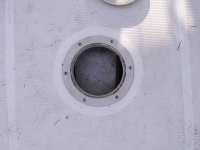thataway
Well-known member
- Joined
- Nov 2, 2003
- Messages
- 21,692
- Reaction score
- 63
- C Dory Year
- 2007
- C Dory Model
- 25 Cruiser
- Hull Identification Number
- DOR25652A707
- Vessel Name
- thataway
I was feeling so good that Frequent Sea didn't seem to have any window or hatch leaks--but today we had a heavy Florida rain. It was susposed to be a "rest" day for me, but I went aboard to check up on some items--and there was over a quart of water on the foreward bunk platform and floor(no cushions present). It was all leaking from a screw holding the inside trim ring JUST LIKE on the Tom Cat 255, Thataway! Pulling the trim ring showed some dirt and water, and drops from a second screw hole. It took me over an hour to get the hatch rim off. The bedding compund was probably 4200 or 5200. I have all sorts of thin slicks and knifes so I cut all of the sealant. When I pulled it free (photos in Thataway Album 148 to 151), there was almost no caulking on the foreward part of the aft rim of the lip of the opening or the hatch frame! The plywood core was wet, and there was water in some of the screw holes. To compound matters, when the deck cutout was done, for some reason the saber saw was angled so that the top of the lip was cut back about 10 to 15 degrees more than the bottom (thinner top than it should be--almost exactly like Thataway's leaking hatch!
I spent 3 hours with heat guns, compressed air at 110 psi (putting the nozzel at one drilled out screw hole forced water thu the plywood, and air thru a void about 20" away from the screw hole. There seemed to be a void where the trim ring screwd into the glass, with water in this void. The water was blown out, and evaoprated. The plywood dryed out. Epoxy coated the raw aft edges of the plywood opening at the lip, and a 10oz layer of glass was laid to cover this raw plywood. In the morning, the screw holes will be filled with epoyx and filler, the rim built back to where it belongs (adding another 1/4" of microfibers, cabosil and filler, plus fairing the lip). The aluminum hatch lip was cleaned with chizzels, several different grades of wire brushes and acetone (what ever sealant was used is still disolved by acetone). Sometime tomarrow, the hatch will go back on (if it is not raining) with proper amounts of 4200 and the assurance that there is a complete seal.
This is not a design flaw--The defect that 2003 CD 25 has it is the same type of problem I encountered in the Tom Cat 255 which was built in May 2006. This is a quality control problem, which should have never happened in either boat. I am not going to point fingers at factories or people. The C Dory administration is getting a copy of this post. Yes, both of these items are past history, but this type of carelessness on someone's part is what hurts all of us. It is not a big deal for me to fix this sort of thing, and I do it gladly--but what about the owner who does not realize that there is a problem, which will get worse with time?
I spent 3 hours with heat guns, compressed air at 110 psi (putting the nozzel at one drilled out screw hole forced water thu the plywood, and air thru a void about 20" away from the screw hole. There seemed to be a void where the trim ring screwd into the glass, with water in this void. The water was blown out, and evaoprated. The plywood dryed out. Epoxy coated the raw aft edges of the plywood opening at the lip, and a 10oz layer of glass was laid to cover this raw plywood. In the morning, the screw holes will be filled with epoyx and filler, the rim built back to where it belongs (adding another 1/4" of microfibers, cabosil and filler, plus fairing the lip). The aluminum hatch lip was cleaned with chizzels, several different grades of wire brushes and acetone (what ever sealant was used is still disolved by acetone). Sometime tomarrow, the hatch will go back on (if it is not raining) with proper amounts of 4200 and the assurance that there is a complete seal.
This is not a design flaw--The defect that 2003 CD 25 has it is the same type of problem I encountered in the Tom Cat 255 which was built in May 2006. This is a quality control problem, which should have never happened in either boat. I am not going to point fingers at factories or people. The C Dory administration is getting a copy of this post. Yes, both of these items are past history, but this type of carelessness on someone's part is what hurts all of us. It is not a big deal for me to fix this sort of thing, and I do it gladly--but what about the owner who does not realize that there is a problem, which will get worse with time?

